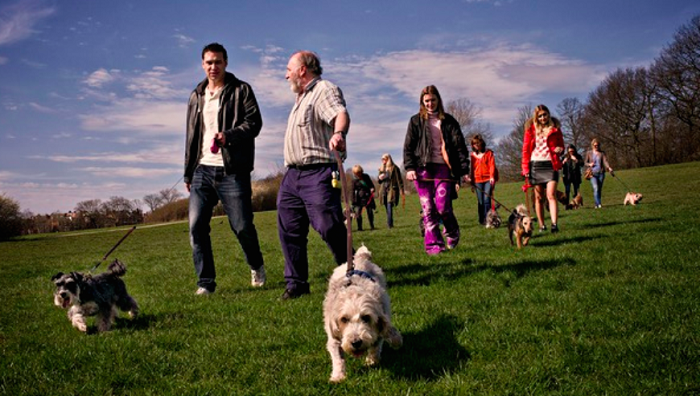5 Dog Walking Rules for Safe and Enjoyable Walks

People walking dogs early in the morning at Lake Gardens, a relatively new suburb on the western rural-urban fringe of Ballarat, Victoria in Australia. Photo: Flickr CC/ Ed Dunens
Everything about owning a dog seems to lend itself to better health and wellbeing. Just the simple act of petting a dog lowers heart rate, reduces stress and improves mood. You even feel safer when you’re a dog owner living with your dog at home.
When you own a dog, it fills your heart with joy and warmth caring for it and also helps you keep fit and active. You stave off depression and are motivated to exercise every day. This is because you are required to walk your dog regularly, which allows both you and your dog to get physical exercise, social interaction, and a chance to keep tabs on the neighborhood.
In fact, a study in the journal Gerontologist found that older adults who walked dogs experienced “lower body mass index, fewer activities of daily living limitations, fewer doctor visits, and more frequent moderate and vigorous exercise.” Any amount of activity beyond what you're currently doing will likely benefit your health.
However, while beneficial to both you and your dog’s overall health and wellbeing, walking your dog can be a time-consuming activity in your daily schedule, especially if you live in a big city and are involved in the hustle and of city life. You need to organize your day well and adjust it for the needs of your dog and its daily walking requirement.
Dog Walking Rules and Tips for Everyone

Man walking brown short coated dog through less trodden area. Photo / Pikrepo.
Here are some effective dog walking rules and tips to safely meet this daily walking requirement, particularly if you live in an urban area or city.
Rule #1: Never leave the dog alone on walks.
Of course, the situation may occur when you urgently need to go, for example, to a store or pharmacy - and then you have to leave the dog on a leash. But you must not constantly and habitually leave the animal like this, because:
- You endanger its health and even its life. What if the dog jumps out on to the road? Do not think that accidents can’t happen. Dogs can sometimes behave unpredictably, especially when out in the streets.
- The dog can be a threat to people on the street and especially to children. So, if you regularly walk it in the city, be sure to take insurance for your pet. This will protect the dog in case of injury, as well as your wallet if the dog suddenly attacks someone on the road or damages people’s property out there.
- City and municipal authorities are obliged to catch abandoned dogs, which does not always end well for the animals. This is why it is essential to attach a badge to the collar indicating your contact address or phone number.
In general, be careful and very vigilant before leaving your dog on walks. Actually, your dog should not take a step to the side without your knowledge and permission. So, always put a leash and collar on the dog when going for a walk with it. Try off-leash dog walks only when you are in safe, non-populated areas and are sure your dog won’t run away.
Rule #2: Pick less visited squares and parks.
When choosing a place for walking with a dog, give preference to rarely visited squares and parks, and other less popular areas where there is low human traffic. This is where it will be safest to organize fun outdoor games with your dog without encountering interference.
It is forbidden to walk pets in areas such as schools and kindergartens. And you should also strictly observe the requirement to pick after the dog and remove any dog excrement.

Golden Retriever chasing woman wearing bubble hat having fan. Photo / Pikrepo
Rule #3: Take the optimal number of walks in a day for your dog.
But how many dog walks is considered optimal? Well, according to pet care experts, young, healthy canines are required to go out for a walk at the very least twice a day.
As a general rule, however, you should walk your dog 3 – 4 times per day, depending on your dog's breed, age, size and health conditions.
Whereas even just one walk per day may be enough for smaller dogs, high-energy dog breeds will require more than that. So, observe your dog to determine its energy level.
The question of how much time to walk is also important. For the busy dog owners who believe that 15-20 minutes walk will always be enough for the dog, well, you may be mistaken.
Every dog owner needs to understand that dogs need walks to exercise, sniff and engage with their environment, for metal stimulation, and also to play and bond with you and perhaps socialize with other people and dogs, as well.
Therefore, ideally, set aside at least 40-60 minutes in your daily schedule for a walk with your dog. That should make the walk truly rich, satisfying and pleasurable for the dog.
Rule #4: Put a muzzle on the dog where necessary
If you’re walking an unruly, excitable, disobedient or aggressive dog and you have to spend time in crowded places, then put a muzzle on the dog. It’s better to play it safe than be sorry.
Do not remove the muzzle if there is no adjustment in the dog’s behavior, until you are back home in safe environments. And do not let go of the leash while walking the dog.
Remember, others are not to blame for the fact that you have an angry and uncooperative dog that does not heed your commands.
You, as the owner, are responsible for everything that your dog does.
Rule #5: Schedule dog meetups and dog walking-groups

People out group dog-walking. Image credit: Sarah Lee/the Guardian.
Dogs enjoy scheduled meetups with other dogs. Schedule dog meetups and group-walks for your dog to interact with other dogs. Walking in a group means you get to share experiences with other dog owners, as well.
When you are going for a walk with your four-legged friend, you may wonder where to go so that your dog can meet up with its kind and socialize. For its wild ancestors, the best walks were places with endless steppes and shady forests. Go there to have plenty of fun and great hunts.
The rest of the time, try to get out of the city square so that the dog can wander at least a little while in the grass. In the most extreme case, the asphalt of city sidewalks is also suitable. But, try not to let the exercise time fall on the hot midday hours - fumes from the surface have a terrible effect on the pet’s well-being, and hot asphalt can burn paw pads.
Social meetups for your dog is one of the best ways to ensure that it becomes a friendly and confident pet. So, take your dog out to socialize with other pets and even other humans - it is good for their health.






















